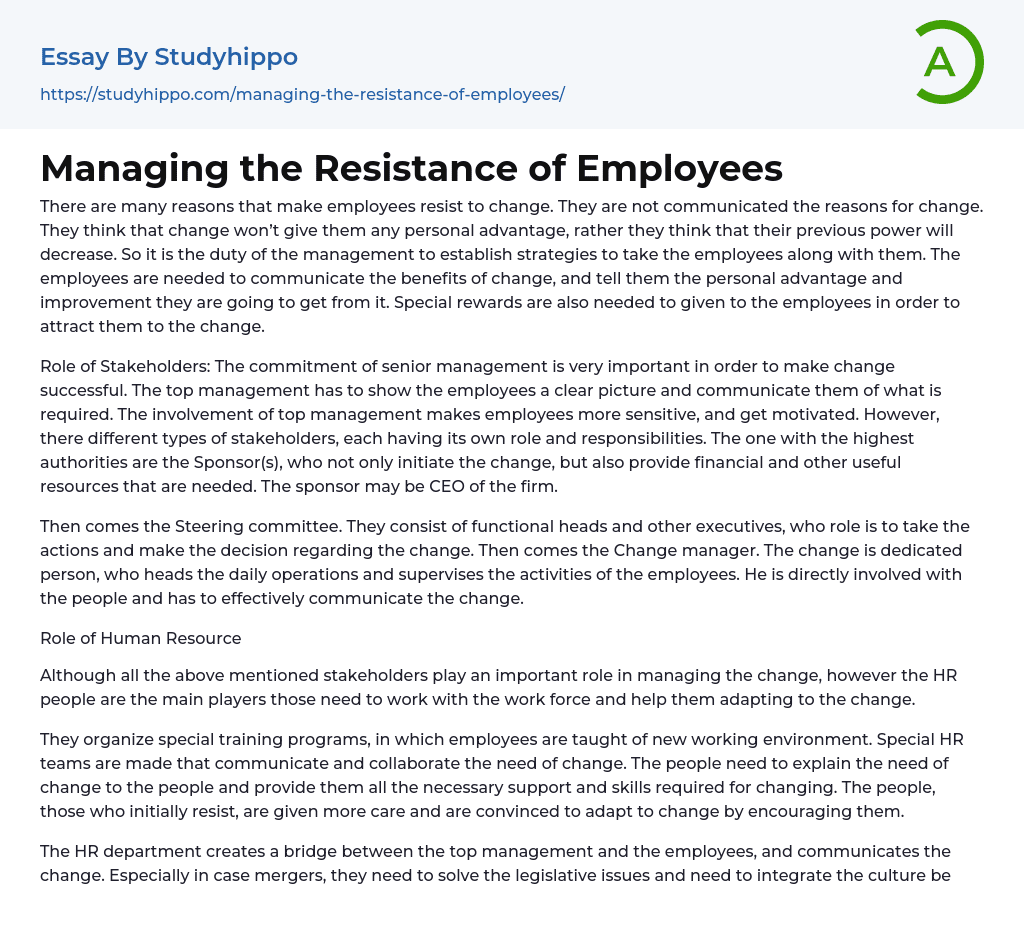Insufficient communication regarding the reasons for change is one of the various causes behind employees' resistance to change.
Management should take responsibility for creating strategies that involve employees in the change process, as they believe it will not personally benefit them but instead diminish their previous power. To ensure acceptance of change, employees must be informed about the advantages and improvements they will gain, and special rewards should be implemented to incentivize their acceptance. The commitment of senior management is crucial for ensuring the success of the change.
The involvement of top management is crucial in providing clear communication and motivation to employees. Various stakeholders play different roles and have specific responsibilities. The Sponsor(s) hold the highest authority and not only initiate the change but also provide necessary financial and resources. The Sponsor, who may be the CEO, is foll
...owed by the Steering committee.
Within the change management process, there are functional heads and executives who are responsible for making decisions and taking actions. Alongside them is the Change manager, a dedicated individual who oversees daily operations and supervises employees. The Change manager is directly involved with the people affected by the change and must effectively communicate it.
The Role of Human Resource
Among all stakeholders involved in managing the change, Human Resource (HR) personnel play a crucial role. They collaborate with the workforce to facilitate their adaptation to the change. HR organizes specialized training programs aimed at familiarizing employees with the new working environment.
Special HR teams are created to communicate and collaborate the need for change. It is crucial for these teams to explain and provide the necessary support and skills to individuals who need to adapt. Those who
initially resist the change are given extra care and persuaded to embrace it through encouragement. The HR department serves as a link between top management and employees, effectively communicating the proposed changes. In particular, during mergers, they are responsible for addressing legal matters and integrating the cultures of the combined firms.
They develop strategies to foster understanding between the organizational cultures of the firms.
References
- Mike Bourne, Pippa Bourne (2007) Change Management in a week. London: Hodder ; Stiughton Educational
- Donald L. Kirkpatrick (2002) Managing Change Effectively. Boston: Butterworth-Heinemann publications.
- Gunter Stahl, Mark Mendenhall (2005) Mergers and Acquisitions: Managing Culture and Human Resources: Stanford University Press
- Ethan A. Winning (2005) HR's Role in Mergers and Acquisitions. Retrieved February 18, 2008, from Website: http://www. ewin. com/articles/manda.
htm
- Being A Leader essays
- Servant Leadership essays
- Leadership Experience essays
- Leadership Qualities essays
- Career Choice essays
- Career Goals essays
- Career Plan essays
- Community Service essays
- Dream Job essays
- Duty essays
- Employee essays
- Internship essays
- Interview essays
- Job essays
- Job Interview essays
- Performance Appraisal essays
- Portfolio essays
- Service essays
- Skills essays
- Vocation essays
- Work Experience essays
- Work-Life Balance essays
- Board Of Directors essays
- Brand Management essays
- Business Ethics essays
- Business Management essays
- Change Management essays
- Comparative Analysis essays
- Decision Making essays
- Dispute Resolution essays
- Knowledge Management essays
- Leadership essays
- Leadership and Management essays
- Manager essays
- Operations Management essays
- Performance Management essays
- Product Management essays
- Project Management essays
- Quality Management essays
- Risk essays
- Risk Management essays
- Scientific Management essays
- Stress Management essays
- supply chain management essays
- Time Management essays
- Total Quality Management essays
- Code of Ethics essays
- Conflict essays
- Dress Code essays
- Human Resources essays




